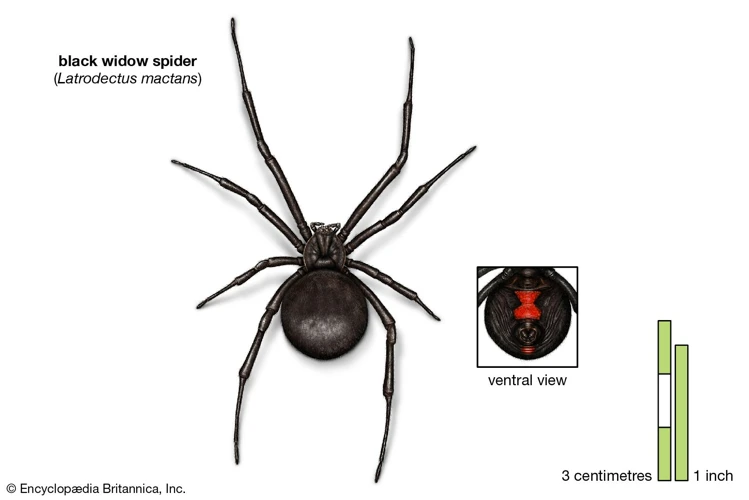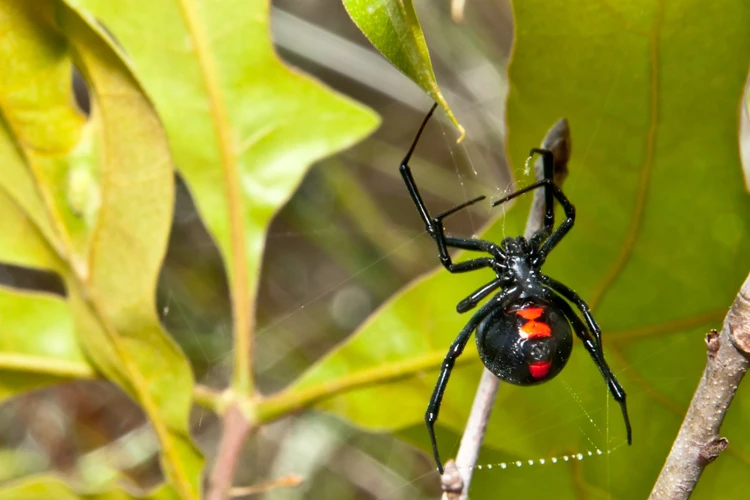As one of the most feared and revered arachnids on the planet, the black widow spider has long been a subject of fascination for scientists and laymen alike. Yet despite their notoriety, there is still much we don’t understand about these enigmatic creatures, including the role that hormones play in their development and behavior. In this article, we’ll delve into the fascinating world of black widow spiders and explore the complex interplay between hormones and the maturation process. From their anatomy to their life cycle and beyond, we’ll reveal the secrets of these intriguing arthropods and shed new light on their remarkable biology.
Anatomy of Black Widow Spiders

The anatomy of Black Widow Spiders is a fascinating subject that is often overlooked. The unique physical characteristics of these spiders play a crucial role in their maturation and reproductive success. Understanding the anatomy of Black Widow Spiders requires an exploration of the various hormones that influence their development. In this article, we’ll delve into the anatomy of Black Widow Spiders and examine the hormonal processes that aid in their maturation. We’ll also discuss the behavioral changes that accompany the spiders’ physical development. But before we delve into the roles of hormones, let’s first explore the anatomy of Black Widow Spiders. For more information on the maturation of Black Widow Spiders, check out our article on maturation rate of Black Widow Spiders.
Hormones Involved in Anatomy Development
The development of the anatomy of black widow spiders is intricately linked with several hormones that trigger specific growth and development processes at different stages of their life cycle. The most important hormones involved in the anatomy development of black widow spiders include ecdysone, juvenile hormone, and prothoracotropic hormone.
Ecdysone is responsible for triggering molting in black widow spiders. Molting is a process where black widow spiders shed their exoskeletons to grow and develop new body parts. The juvenile hormone is responsible for determining the fate of molting. It influences the development of different organs, including the reproductive system, nervous system, and muscles.
Prothoracotropic hormone (PTTH) plays an essential role in the growth and development of black widow spiders, especially the thoracic region. PTTH controls the release of ecdysone, which, in turn, triggers molting. The timing and level of PTTH and ecdysone influence the development of different body parts, such as the chelicerae, the venom glands, and the spinnerets, which together make up the anatomy of black widow spiders.
Research has shown that hormonal imbalances can have serious consequences on the maturation and survival of black widow spiders. For instance, studies have shown that threshold mortality rate increases in black widows exposed to environmental stressors, such as human-induced habitat disturbance. Similarly, comparative studies suggest that male black widows mature at a faster rate than females, which also indicates an impact of the hormonal system.
In summary, hormonal control plays an essential role in the development of black widow spiders. The anatomy of black widows is influenced by hormones such as ecdysone, juvenile hormone, and prothoracotropic hormone. Any hormonal imbalances can lead to changes in the development or maturation rates, which can ultimately impact the survival and population density of black widows.
Life Cycle of Black Widow Spiders

As for the life cycle of Black Widow spiders, it is a fascinating process that involves various stages. From hatching as spiderlings to reaching adult size, these arachnids go through multiple molts and require specific environmental conditions for maturation. Hormones play a crucial role in every stage of development, dictating when and how a Black Widow spider will grow and mature. In fact, a comparative study of maturation in male and female Black Widow spiders reveals some intriguing differences. Let’s explore the physiological processes behind the life cycle of these venomous spiders and how hormonal influences shape their development.
Hormonal Control of Stages of Life Cycle
During the life cycle of black widow spiders, hormones play a crucial role in controlling the various stages of development. From hatching to adulthood, hormones released by the endocrine system affect the spider’s growth, rate of maturation, and reproductive capabilities.
Hatchlings: The first stage of a black widow spider’s life cycle is the hatchling stage. During this phase, hormones such as juvenile hormone and ecdysone are responsible for regulating molting and growth. Hatchlings require a steady supply of nutrients to facilitate the rapid growth necessary to reach the next stage.
Juveniles: Juvenile black widow spiders continue to rely on juvenile hormone, which is produced in the corpora allata gland, to regulate molting and growth. Additionally, hormones such as prothoracicotropic hormone stimulate ecdysone production, signaling the spider to molt and grow. During this stage, females begin to develop a distinct black and red coloration, which will eventually signal their readiness to mate.
Subadults: As black widow spiders enter the subadult stage, their rate of maturation begins to slow. Hormones, including ecdysone and juvenile hormone, continue to play a role in molting and growth but at a slower pace. Female black widows may reach sexual maturity during this stage, but males will take longer to mature.
Adults: Hormones released during the final stages of black widow spider maturation play a significant role in the spider’s behavior and reproductive success. Females require a specific hormonal balance to signal their readiness to mate and produce viable egg sacs. Hormones such as estradiol regulate female behavior, including hunting and mating, while testosterone is responsible for male mating behavior.
It is important to note that various factors can impact the hormonal control of the black widow spider life cycle. For example, population density and environmental stressors can affect the rate of maturation and reproduction. Additionally, human interference and habitat destruction can drastically alter hormonal balances in black widow spider populations.
A comparative study of maturation rates in male and female black widows reveals interesting insights into the role of hormones in shaping behavior and reproduction. Understanding the hormonal control of the black widow spider life cycle is critical for effective population management and conservation efforts.
Effects of Hormones on Reproductive Maturity
During the maturation process, hormones play a huge role in the reproductive maturity of Black Widow spiders. The hormones control and regulate different aspects of the spiders’ development, including the timing of their reproductive maturity. The levels of hormones fluctuate throughout the spiders’ life cycle, with certain hormones playing a more prominent role in reproductive maturity than others.
Here are some of the effects of hormones on reproductive maturity in Black Widow spiders:
- Estrogen levels increase as the female spider approaches reproductive maturity. This hormone is responsible for the development of the female reproductive system.
- Progesterone levels also increase in female spiders during the reproductive phase. This hormone helps prepare the spider’s body for pregnancy and controls the production of certain enzymes necessary for egg-laying.
- Testosterone levels rise in male spiders during their maturation phase. This hormone is responsible for the development of the male reproductive system.
- High levels of luteinizing hormone (LH) and follicle-stimulating hormone (FSH) have been observed during the reproductive phase of female Black Widow spiders. These hormones control the production of eggs and promote ovulation.
- Additionally, hormonal imbalances or irregularities can cause issues in reproductive maturity for Black Widow spiders. For example, an excess of estrogen can lead to infertility in female spiders, while low testosterone levels can lead to reduced mating success in males.
Understanding the effects of hormones on reproductive maturity in Black Widow spiders is important when studying their behavior and survival. A comparative study of male and female Black Widow spiders’ maturation rates and behaviors could provide insight into their reproductive success and overall survival rates. Environmental factors such as human impact can also impact the hormonal levels and maturation rates of Black Widow spiders, potentially leading to negative consequences for their populations.
Internal link: fem-black-widow-maturation
Behavioral Changes in Maturation
As black widow spiders reach maturity, their physical and physiological changes are accompanied by significant behavioral transformations. These alterations are driven by hormonal changes that affect the spider’s hunting and mating behaviors. These changes are crucial for the spider’s survival and reproduction. Studies have shown that the maturation rate of black widow spiders can be influenced by various environmental factors, including human impact on their habitats. In this section, we will dive deeper into the behavioral changes that occur during black widow spider maturation and explore the hormonal influences on these behaviors.
Hormonal Influences on Hunting and Mating Behaviors
During the maturation process of Black Widow spiders, hormonal influences play a crucial role in their hunting and mating behaviors. Once female Black Widow spiders reach sexual maturity, they release pheromones to attract males for mating. These pheromones are produced by the silk glands and are regulated by hormones, such as juvenile hormone and ecdysone.
The hunting behavior of Black Widow spiders is also controlled by hormones. For instance, the hunger hormone, ghrelin, controls the spiders’ feeding behavior. When there is a shortage of prey, ghrelin levels rise, enhancing their hunting motivation.
Hormones also influence the decision-making process during mating. Hormonal changes alter the behavior of female Black Widow spiders towards male spiders, leading to acceptance or rejection of the male. For example, in a comparative study (source), it was found that female Black Widow spiders become more aggressive during the mating season due to an increased level of testosterone hormone.
Hormones play a vital role in the hunting and mating behaviors of Black Widow spiders. By better understanding these hormonal influences, we can obtain valuable insights into the maturation process of these unique arachnids. These insights can assist in mitigating any potential human impacts on their survival, maturation rate and maturation risk.
Conclusion
The Role of Hormones in the Maturation of Black Widow Spiders
In conclusion, the influence of hormones on black widow spiders’ development and maturation is undeniably significant. Hormones largely dictate the size, morphology, and functionality of their anatomy, which ultimately affects their chances of survival. The growth rate and survival of black widow spiders largely depend on the appropriate level and timings of hormone secretion during critical developmental stages.
Moreover, hormonal regulation plays a crucial role in the behavioral changes that occur during the maturation of black widow spiders. Their hunting and mating behaviors are intricately linked to the presence of certain hormones in their systems. From aggressive hunting tactics to improved reproductive success, hormones play a crucial role in shaping the maturation process of these spiders.
Understanding the role of hormones in the maturation of black widow spiders can help researchers and enthusiasts alike appreciate the complexity of these creatures better. Moreover, this knowledge can help inform efforts aimed at preserving and conserving the black widow spider species. By ensuring regulated hormone secretion, efforts can be leveraged to improve the maturation rates and survival of these remarkable spiders.
In summary, hormone regulation is vital in shaping both the anatomy and behavioral development of black widow spiders. Inadequate hormone secretion can negatively influence their maturation, impacting their survival rates. This article highlights the critical role hormones play in the maturation of black widow spiders and highlights the importance of hormone regulation in improving maturation rates and ensuring the long-term survival of this fascinating spider species.
Frequently Asked Questions
1. How long does it take for a black widow spider to mature?
It takes about 3-4 months for a black widow spider to mature.
2. What are the hormonal changes during a black widow spider’s maturation?
During a black widow spider’s maturation, there is an increase in the levels of juvenile hormone and ecdysone while the levels of prothoracicotropic hormone decrease.
3. How does hormonal control affect the life cycle of black widow spiders?
Hormonal control plays a crucial role in the life cycle of black widow spiders. Hormones such as juvenile hormone, ecdysone, and prothoracicotropic hormone regulate the various stages of the spider’s life cycle.
4. What are the effects of hormones on the sexual maturity of black widow spiders?
Hormones such as juvenile hormone and ecdysone influence the sexual maturity of black widow spiders. An increase in juvenile hormone levels can delay the onset of sexual maturity while increasing levels of ecdysone can accelerate it.
5. How do hormones affect the hunting behavior of black widow spiders?
Hormones such as dopamine and serotonin play a role in the hunting behavior of black widow spiders. Dopamine increases the aggression of the spider while serotonin decreases it.
6. Do all black widow spiders exhibit the same mating behavior?
No, different species of black widow spiders can exhibit different mating behaviors.
7. What is the function of pheromones in the mating behavior of black widow spiders?
Pheromones are chemical signals released by female black widow spiders to attract potential mates. Males can identify a female’s pheromones and use them to locate her.
8. Can black widow spiders mate multiple times?
Yes, female black widow spiders can mate multiple times and can keep sperm from different males in separate storage organs.
9. Can black widow spiders be kept as pets?
Yes, black widow spiders can be kept as pets by experienced keepers. However, they are highly venomous and require specialized care.
10. Are black widow spiders endangered?
Black widow spiders are not considered endangered, as they have adapted well to human-influenced environments and can be found in almost every part of the world.






